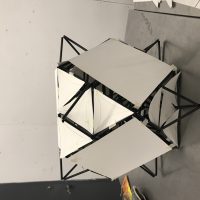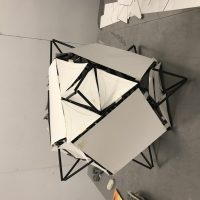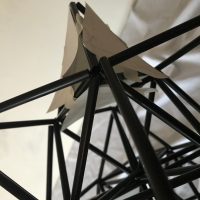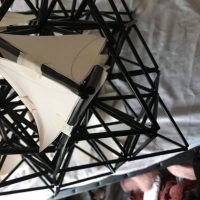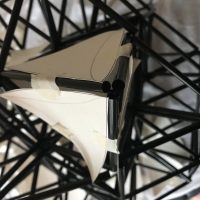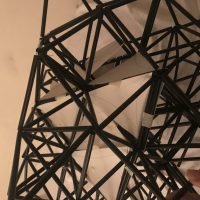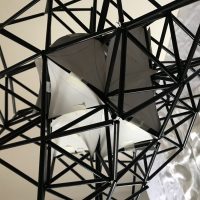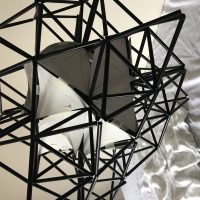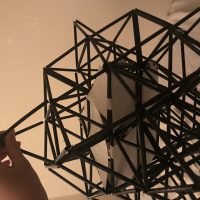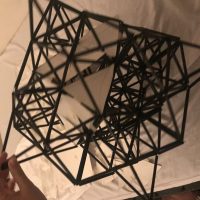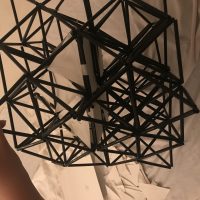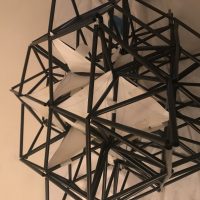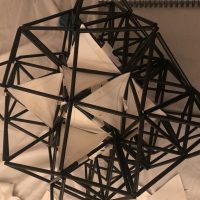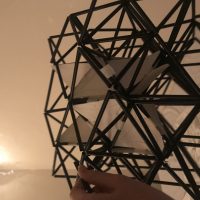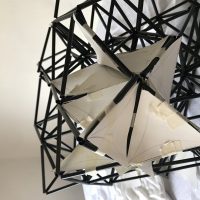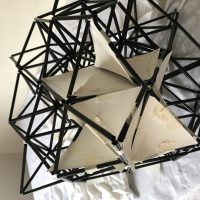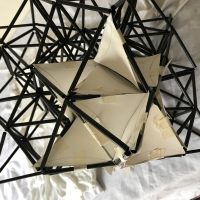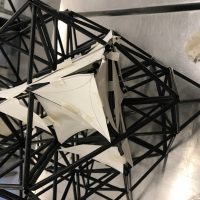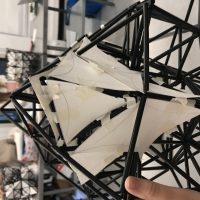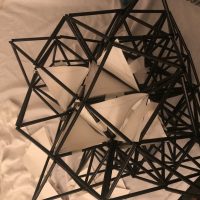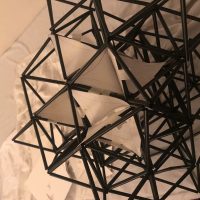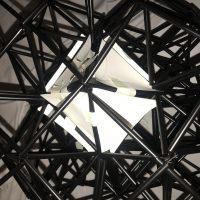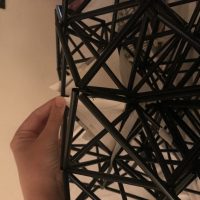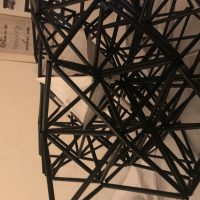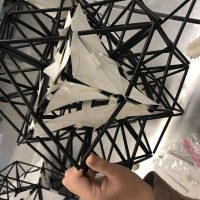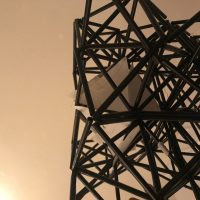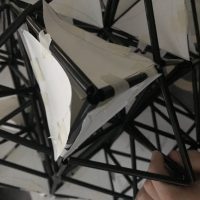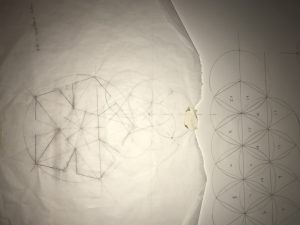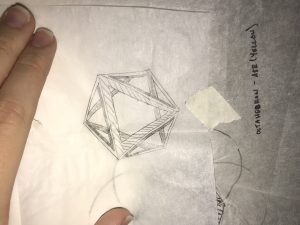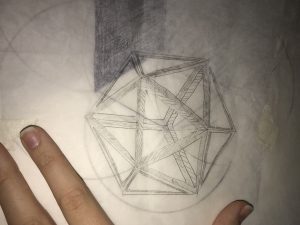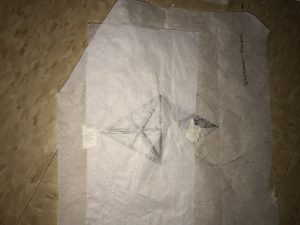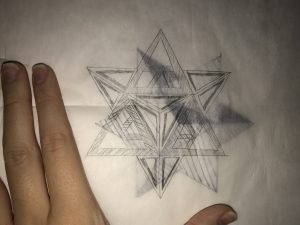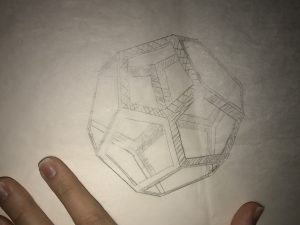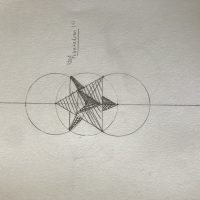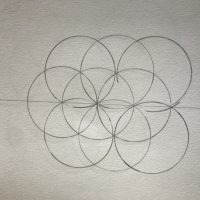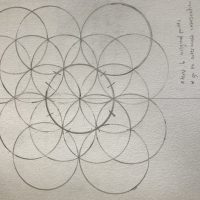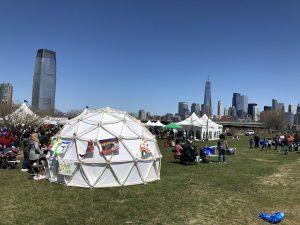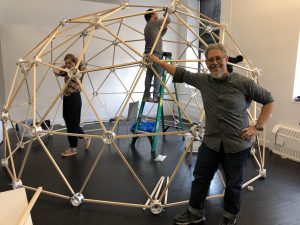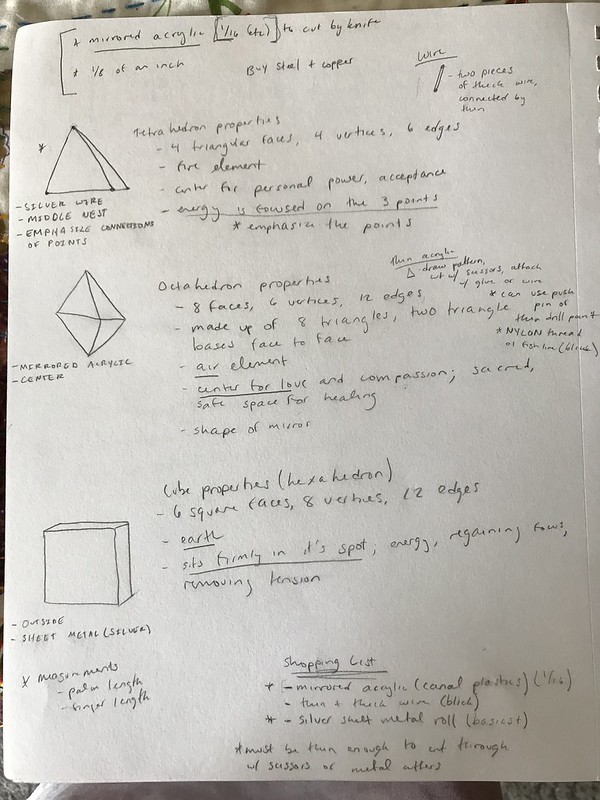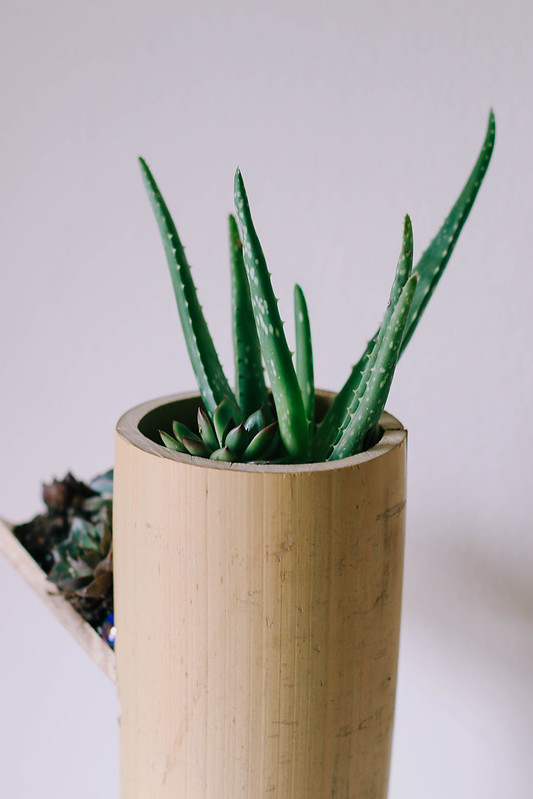Platonic Solid Shapes, Paper Forms Inside Constructed Straw Form
I really enjoyed making the straw tetrahedrons. Though the making was tedious, I liked seeing how they all came together to make one larger piece. I made a lot of mistakes in the original forms in the beginning, but then eventually figured out a pattern to weaving them together that was sort of enjoyable. I really liked seeing them all come together. This was my first time making a sculpture-like object out of a non-traditional material – I liked that we used straws, normally not used for making. I also enjoyed the ideas behind the shapes we were beginning to form, and how we started to stack new concepts upon what we had already made.
Pictured above are all the shapes (pictured from different angles) I was able to make inside of the large structure. Below is a photo of my sketchbook. The only shapes I wasn’t able to figure out were the cube (both large and small), and the small cube octahedron. The shapes were somewhat difficult for me to find, because the exercise required me to look at the whole with an entirely new perspective. It was very satisfying when I did find the shapes.
I found this assignment specifically challenging because of the nature of picturing a 3D object without seeing them first. I had difficulty making a lot of the shapes out of paper inside the star tetrahedrons, but once someone pointed them out to me they seemed obvious. I spent a lot of time trying to find the cube, and still couldn’t picture it, but once I saw someone else’s in class it made so much sense. This showed me how difficult it is for me to think in 3D – visualizing something before it is made isn’t one of my strongest skills. .
Isometric Drawing: Platonic Solids
Below are the drawings I did of the 3-D platonic solids, with openings and shading. This helped me to better visualize the shape I was creating on paper before constructing it out of cardboard. It also helped me to take the 2-D model and make something larger out of it, understanding it’s meaning and form.
I really enjoyed this assignment. In addition to the stories and ideology behind the shapes and structures, my favorite part of the class was definitely the 3D drawing. I didn’t know it was possible to build on an original form in 2D in such complex ways, and it felt very simple to me once I learned the technique. I also really liked the look of the final drawings. Sometimes precision is difficult for me, but these felt very neat and precise.
Isometric Drawing: Before Sketches
Here are some photos of sketches I did in class to help me visualize the shapes before creating the final drawings.
Imbedded Platonic Solids (Cardboard)
These photos were taken at two different stages in the imbedding of the shapes and several angles. My final shape, the icosahedron wasn’t able to properly nest on top of the dodecahedron, and the cube fit a little too tightly inside the dodecahedron. Other than those imperfections, I was happy with the outcome of the nested shapes.
Something I enjoyed about making the nested shapes was how it related to the 2D shapes, and also how direct the size relationships were. Even though the mathematical aspects were a bit difficult to me (and my least favorite part of the process), I was really interested to see how well they worked together naturally. My outermost shape didn’t fit properly, and they were all a tight fit – but with more mathematically precision they would have worked really well.
The Dome: Reflection
I’m really happy we decided to take on the dome as a class. I don’t know when I would have had another opportunity to build something so large scale that also has a function. My favorite aspects of the dome were how each teammate had something to bring to the table, and we had to work as a community to form something for the community. It was also interesting to see the dome develop into what it became, as materials and ideas shifted. I liked as well that it served as a collaboration with another program as well. It was definitely a satisfying project. I enjoyed using skills we had learned previously to make something so large and also useful to others. I also was glad that I learned to use a sewing machine in the process, as that will be probably be useful to me, as well as see the process of finding materials that are both functional and sustainable.
Platonic Nest: Sketches and Ideas
For my final project, I did end up using the bamboo offered. But, before that, I made plans to make a nest of platonic solids out of various materials. My nest was based on the properties of each solid, which I found very fascinating – as you can see in the notes below, each solid has an element and energetic focus. I wanted to use those properties to make a nest out of materials that captured the essence of each shape. I began making my middle piece, the tetrahedron (which I was planning to make a star tetrahedron possibly) out of silver and gold wire, focusing on the connection points (as they are where the energy is held). My innermost solid was planned to be the octahedron, made from mirrored acrylic, as it represents the air element and is the center for love and compassion. My outermost solid was to be the cube, made from sheet metal, as it’s meant to represent earth and sit firmly where it’s placed.
I was greatly interested in the ideas behind the solids, but I chose to work with the bamboo instead because I felt I didn’t quite have the technical skills to execute my ideas as flawlessly as I saw them in my head. I felt that working with a more natural material I may be able to make something that both is pleasing visually and executes my ideas.
Final Project
For my last project, I used one of the large pieces of bamboo to create a planter. I wanted to make something that was both pleasing to the eye and functional. In home decoration, I love a modern and minimalistic look that also feels a bit earthy. My piece captures this aesthetic – as a designer, I wanted to create something I would personally like and use. I enjoyed the natural look of the bamboo, so I wanted to also utilize that in the final aesthetic of my piece. To construct this, I sawed off one section of the bamboo, sawed that section into halves (creating the shelves), and made holes in the original structure to hold the shelves containing the plants. The whole structure is filled with dirt, spilling out onto the shelves, and has a filtration system at the bottom containing of drilled holes and glass pebbles.
This project was by far my favorite part of Space + Materiality – though it didn’t really include the ideology and stories that a lot of our other work did, I felt that I had a lot of freedom to create something both useful and interesting. I was able to include personal style and also the opportunity to work with a material I never would have thought to use. I love the finished look with the plants, and the way that all the different pieces fit together to make something both sleek and natural in aesthetic.
